Grasshoppers are abundant in Florida. Most of the grasshoppers in the state only live up to a year.
While all of them lay eggs in the ground, grasshoppers in Florida eat different types of food. Some only consume broadleaf vegetation while others are tied to a very specific type of plant only.
Here are the most common types of Grasshoppers in Florida.
Table of Contents
1. Eastern Lubber Grasshopper
These are the most common grasshoppers in Florida and other Southern states. The Eastern Lubber Grasshopper is mostly yellow with black spots.
It can be recognized by a robust body with slender legs. This makes it easy to recognize in its natural habitat, mainly in thick vegetation.

This grasshopper (Romalea microptera) likes to eat the leaves of various plants and shrubs. It believes it will only eat the leaves of 38 types of plants such as shrubs and herbs.
The Eastern Lubber Grasshopper hurts crops. They also affect decorative plants in residential areas. The grasshopper frequently eats lettuce, kale, and beans, making it a real concern for crop owners.
2. American Bird Grasshopper

The American Bird Grasshopper (Schistocerca americana) or the America Grasshopper is very common in Florida. This North American endemic species is known for its ability to change body color throughout its life.
Two generations of America Bird Grasshoppers occur per year. They change colors depending on their environment, temperature, and age. This is not uncommon in grasshoppers.
In Florida, these invertebrates are known for their negative impact on citrus trees. While they aren’t considered a large threat to crops, they can still create problems around crops when their population number rises.
These grasshoppers can devour all leaves of citruses. However, it also eats corn, sugarcane, and tobacco leaves.
3. Southern Green-striped Grasshopper

These grasshoppers (Chortophaga australior) grow to a maximum size of 38mm. Females are larger than males typically growing between 28 and 38mm. Males grow up to 30mm.
Telling apart males from females is difficult if choosing not to consider color. The Southern Green-striped grasshopper female is green while the male is brown.
These invertebrates prefer grasslands. They are often found in short grass, particularly next to roads where they sometimes wander off to warm up in the sun.
4. Short-winged Green Grasshopper

This common Florida grasshopper (Dichromorpha viridis) is frequently seen in grasslands and lawns until October. It’s a species characterized by its slanted face look.
The female is longer than the male. The male Short-winged Green Grasshopper is green while the female is brown.
These invertebrates are common all along the East Coast. They are frequently seen around lawns. Their impact on decorative plants can be significant. However, their impact is smaller than the impact of the Southern Green-striped Grasshopper.
These grasshoppers are also smaller. They can reach a length of up to 30mm in the case of females and a length of up to 22mm in the case of males.
5. Long-headed Toothpick Grasshopper

This species of grasshoppers (Achurum carinatum) is commonly referred to as toothpick grasshoppers. Their thin elongated bodies make them almost impossible to see in tall grass.
The invertebrate prefers to live in grasslands with very tall grass. Their body color varies. Differentiated by a slanted head, they also feature sword-like antennae.
Unlike other invertebrates such as Short-winged Green Grasshopper, the Long-headed Toothpick Grasshoppers are the most numerous in the fall. They are mostly seen in open woodlands and grasslands and rarely on lawns in suburban habitats.
6. Obscure Bird Grasshopper

These grasshoppers (Schistocerca obscura) are the largest in Florida. They can reach a body length of up to 45mm in the case of males and up to 65mm in the case of females.
They are easy to spot in tall vegetation as a result. Increased body size doesn’t impede their ability to fly.
These are migratory grasshoppers. They can travel very long distances over a short period.
Storms and high winds are used to propel their migratory efforts. While they consume many broadleaf crops, they aren’t seen as particularly dangerous.
While they consume a lot of leaves, they aren’t sufficiently populous for a significant negative impact on crops and decorative vegetation.
7. Marbled Grasshopper

This species of grasshopper (Spharagemon marmorata) is very common in Florida. There are 9 species of Spharagemon in the US and 3 of them are found in Florida. Spharagemon marmorata is the most common among them.
There’s almost no beach in the state without these invertebrates. Since they prefer to live in sand-rich habitats close to water, these also take the color of their environment.
The grasshoppers are mostly gray and brown. Their body is sometimes camouflaged on beaches where it can be mistaken for driftwood. Grasshoppers of the species can fly and they’re difficult to catch as a result.
8. Mischievous Bird Grasshopper

These (Schistocerca damnifica) are some of the smallest grasshoppers in Florida. Generally yellow or orange, they are avid fliers.
With very good abilities to fly, the grasshoppers are part of the Bird invertebrate’s family.
They aren’t seen as particularly dangerous to crops unless they overbreed. In this case, they are particularly harmful to hibiscus cultures. However, it’s only adults that can be harmful to hibiscus as juveniles have very short wings which don’t allow them to fly as well.
9. Atlantic Grasshopper
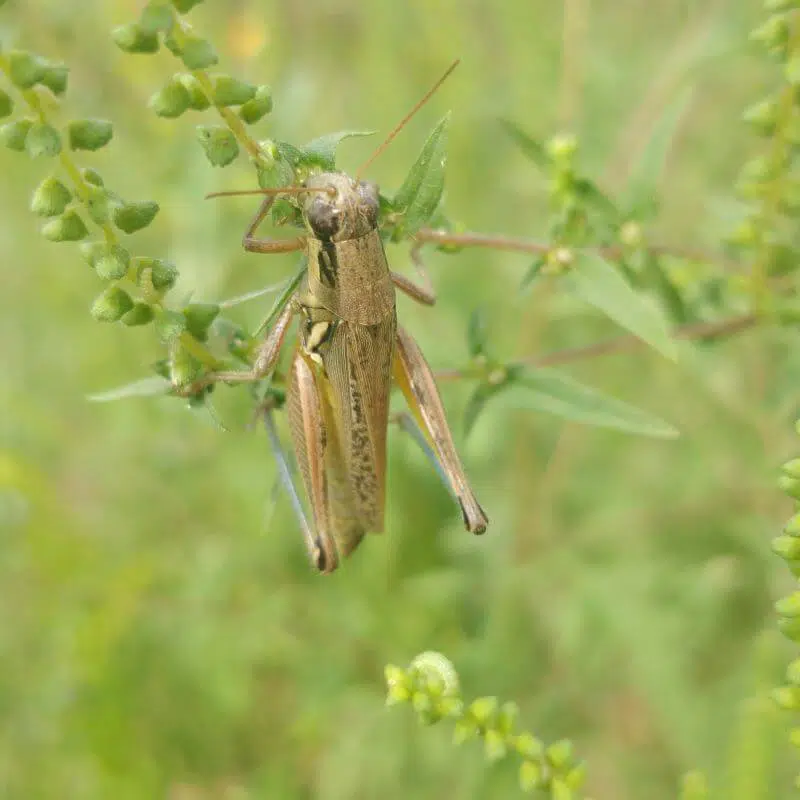
This small species (Paroxya atlantica) of grasshoppers is common in grasslands and on lawns. Its color is normally brown, green, black and white.
Most commonly, this species is confused with the Olive-Green Swamp Grasshopper that only lives in swamps.
The Atlantic Grasshopper isn’t an invasive species problematic to crops. However, it has been seen as one of the invertebrates that can eat a lot of leaves of decorative plants around homes.
Here, the use of pesticides is not recommended to control its population. Pesticides can also harm the plants and other animals around the house.
10. Spotted-winged Grasshopper

This species of slant-faced grasshopper (Orphulella pelidna) is among the most common in Florida. It represents one of the most common grasshoppers in the US, particularly on the East Coast.
It can be identified by its multi-colored striped body. These grasshoppers are typically brown. Their bodies also have black stripes and small black dots.
Preferred habitats include all types of open fields with grasses. They are often seen in the fall but these invertebrates occur throughout the year. They are part of a wider group of grasshoppers under the Orphylella genus.
11. Linear-winged Grasshopper

This type of grasshopper (Aptenopedes sphenarioides) is common in pine areas and the woods of the state. It’s one of the many grasshoppers in the state that can’t fly.
Its inability to fly is mostly impacted by its short wings. The grasshopper moves around on the ground, particularly on grass and other green vegetation.
Its color varies according to gender from green to brown. Young grasshoppers emerge at the beginning of summer. The first adults can be seen in Florida at the beginning of June.
The invertebrates live a long life of up to a year. It’s not uncommon for adults to live until the beginning of the following year until January or February.
12. Brown Winter Grasshopper

This species (Amblytropidia mysteca) is one of the most common brown grasshoppers in Florida. It can be identified by its yellow-brown color.
While most of its body is brown, the grasshopper also has a yellow tint and a golden stripe running along its body.
The species is also known for having very short antennae.
Its preferred habitat includes woodlands and grasslands on woodland edges. It can fly, but it can’t fly too far.
It uses the ability to fly when in danger. The grasshopper flies to an area with tall vegetation where it can hide and escape potential danger.
13. Longhorn Band-wing Grasshopper

This species (Psinidia fenestralis) is another type of grasshopper with short antennae. It’s very common on Florida’s beaches.
With a gray body, this grasshopper quickly mimics the looks of its sandy habitat. It can be seen in sandy areas of the state beginning with July and until October.
The species has similar sizing to most other grasshoppers in Florida’s woodlands. Males are smaller. They can only reach a maximum length of 26mm. Females are larger growing to a maximum length of 36mm.
14. Seaside Grasshopper

As their name suggests, these grasshoppers (Trimerotropis maritima) are mainly found in sand-rich habitats from lakes to river banks. These invertebrates mate late in the year, unlike most other Florida grasshoppers.
They can be identified by their gray bodies with black spots. This helps them blend in with their sandy environments.
The invertebrates are solitary creatures spending most of their lives alone. During the day, they are seen on the sand enjoying the sun. At night, they can sometimes bury themselves in the warm sand completely.
These grasshoppers only become social when mating. Both the female and the male can take care of the eggs once laid. Since the species lives close to water eggs are sometimes subject to tie changes.
Eggs of the species that are laid in water never hatch until the water recedes. The emerging young grasshoppers look like small adults as they don’t change their colors when reaching adulthood.
15. Olive-green Swamp Grasshopper

This grasshopper (Paroxya clavuligera) is identified by its gray color and short antennae. The species is rarely seen as it lives in tall grass and water such as swamps. However, the female is likelier to be seen more since females are larger.
Female Olive-green Swamp Grasshoppers grow to a size of 35mm. Males grow to a size of 25mm.
16. Southern Yellowwinged Grasshopper

This species of grasshoppers (Arphia granulata) is mostly seen in Southern states. It represents a small type of invertebrate with distinct coloring which makes for easy identification.
These grasshoppers are mostly brown. They have light brown or yellow wings. The legs are also light brown with dark brown and black markings.
The head of the grasshopper is always yellow standing out from the rest of the body. Its antennae are short. The antennae are dark brown with thin yellow stripes.
17. Cattail Toothpick Grasshopper

This long and thin grasshopper (Leptysma marginicollis) is typically difficult to spot. Its elongated body often helps the grasshopper remain undetected by potential predators.
It likes to hide behind grass stems. However, this grasshopper isn’t green as the grass it spends most of its time on.
It has a pale brown color. It feeds on grasses and water plants.
The species is known to have 2 generations per year. One generation appears in the spring while its second generation appears in the fall.
18. Rusty Bird Grasshopper

The species is known for its rusty-brown color. It can be identified by a short stocky body and thin elongated legs that are also rusty-brown.
This grasshopper (Schistocerca rubiginosa) is particularly common in peninsular Florida. It lives on dunes and generally in vegetation around beaches.
The species is known for generally living up to a year. Its lifespan depends on the weather.
Eggs are laid late in the year and young grasshoppers are ready to hatch in the spring. The first adults are seen in June. The species mostly survive until October or early November in warmer years.
19. Glassy-winged Toothpick Grasshopper
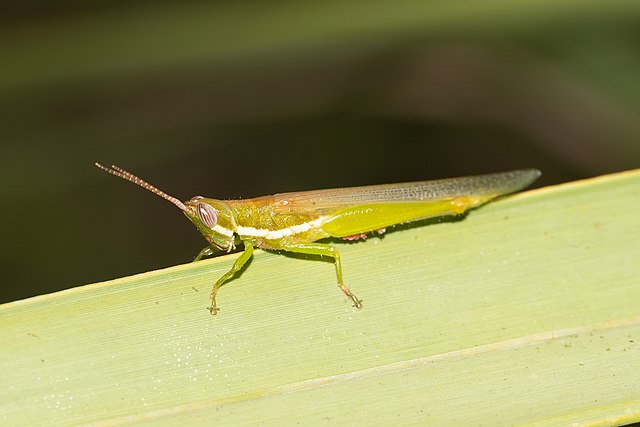
This toothpick grasshopper (Stenacris vitreipennis) is commonly found in Florida, North America, and South America. It has two-toned body coloration.
The upper side of the body is either dark brown or dark green. The lower side of the body is bright green. Its legs are also bright green. Short brown antennae characterized both the male and the female grasshopper.
The species travel long distances easily. First described in 1906, it’s part of a wider subspecies of Stenacris which encompasses 6 types of grasshoppers with similar characteristics.
20. Orange-Winged Grasshopper

This spotted grasshopper (Pardalophora phoenicoptera) is one of the largest in Florida. Males can reach a length of 42mm while females can reach a length of up to 55mm.
The species is known for having the ability to fly. Since the grasshopper is multicolored it typically looks very distinct when flying compared to other grasshoppers.
Research shows this species has different types of defense mechanisms. Vomiting is one of its preferred mechanisms of defense. These grasshoppers vomit when captured.
The vomit is of orange color. It emits an unpleasant scent that is believed to deter some of its potential predators.
21. Clipped-winged Grasshopper

These small green grasshoppers (Metaleptea brevicornis) have short brown antennae. They live in wetlands and they eat grass.
Clipped-wing grasshoppers are very active during the night. They often fly towards light sources when they live close to urban areas.
They eat all types of grasses and they reach adulthood in late July. This is also the ideal time to see these invertebrates since they large live solitary lives as they become adults and start to disperse.
22. Coastal Toothpick Grasshopper

The species (Mermiria intertexta) is known for its common distribution throughout the entire state of Florida. It lives in tall grasses near coastal regions.
It can be identified by its green body and green slanted head. This grasshopper is mostly interested in eating different types of grass.
Its all-green coloring means it blends in tall grass and other types of green vegetation. However, it spends most of its life in this vegetation as it has poor flying abilities.
23. Ridgeback Grasshopper
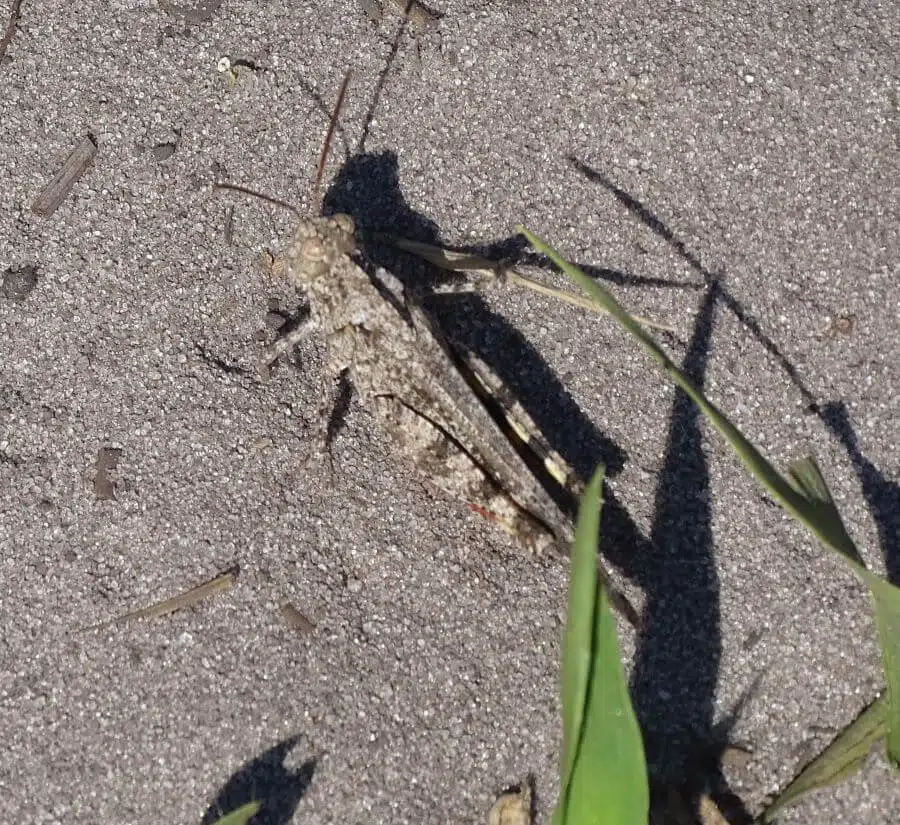
This newly-recognized species (Spharagemon cristatum) has been studied for decades. However, it was only recognized as a separate subspecies in 1984.
It lives near water sources in sandy arid terrains. It’s found in both coastal regions and around lakes where it feeds on various grasses.
This species is very easy to identify as it comes in a gray color with dark gray spots. Both its body and its head are gray. The legs and antennae are also gray. The grasshopper darkens as it matures. The larva is normally of tan color or very light gray coloring.
24. Black-sided Pygmy Grasshopper

This species (Tettigidea lateralis) is known as one of the smallest types of grasshoppers found in Florida. Male Black-sided Pygmy Grasshoppers only grow to a maximum size of 11mm. Females can reach 14mm in size.
As one of the most widespread Tettigidea species, the grasshopper is known for its migratory behavior. Swarms are common and this is the preferred migratory formation of the invertebrate.
Once settled, it prefers all types of habitats which include both dry and wet locations. It can live in swamps but it’s also adapted to living in arid environments such as on dunes around the state.
25. Pine-tree Spur-throat Grasshopper

As one of the most common Melanoplus grasshoppers, the Pine-tree Spur-throat Grasshopper (Melanoplus punctulatus) prefers to live in deciduous forests.
These are forests known for having trees with leaves that fall off. This is why the grasshopper has a camouflage-like color. This helps it stay undetected when on trees or when on the ground among the fallen leaves in the fall.
The grasshopper uses trees in its breeding period. Female grasshoppers lay eggs in trunks of trees. It’s not sure if the species is diurnal or nocturnal. However, young grasshoppers of the species are often attracted by light at night.
Identification of the species can also be based on the large body sizes. Females can grow to an adult size between 37 and 45mm. Males grow to a size between 27 and 31mm.
26. Elegant Grasshopper
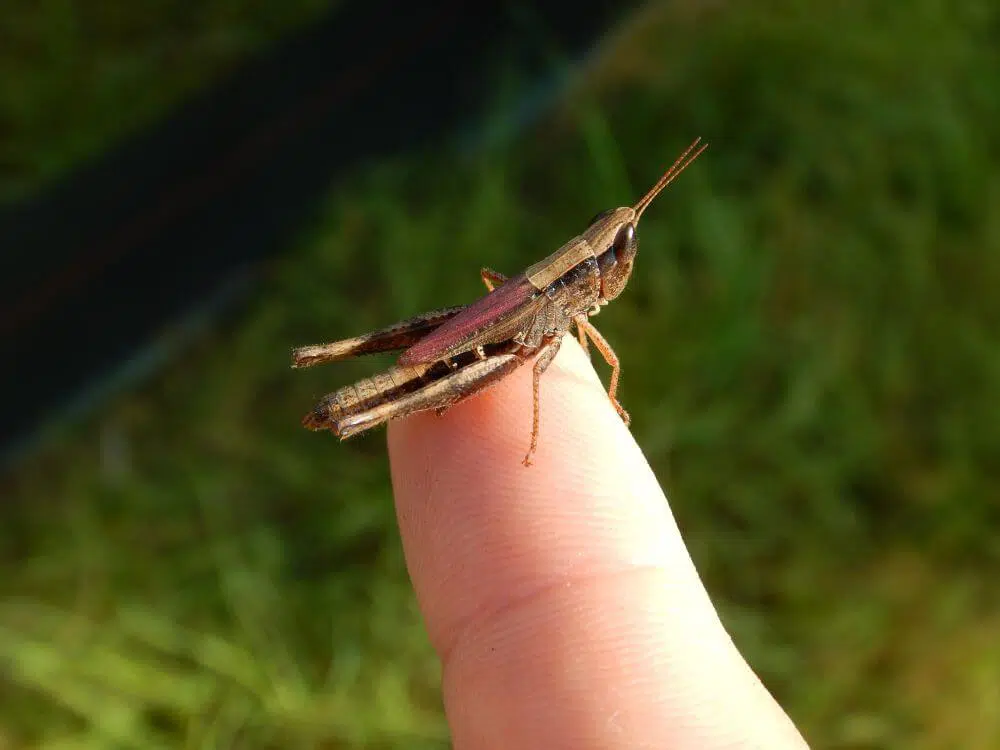
Part of the Dichromorpha species, the Elegant Grasshopper (Dichromorpha elegans) is known for its vivid coloring. This is a multi-colored grasshopper that’s easily identifiable.
It has a yellow and blue body with yellow and red wings. It features striped legs and striped blue antennae.
When it inhabits wetlands its color can be darker to various tones of brown. This type of grasshopper mainly feeds on leaves but it has no dangerousness to agriculture as it doesn’t multiply at a high rate.
27. Crepitating Grasshopper
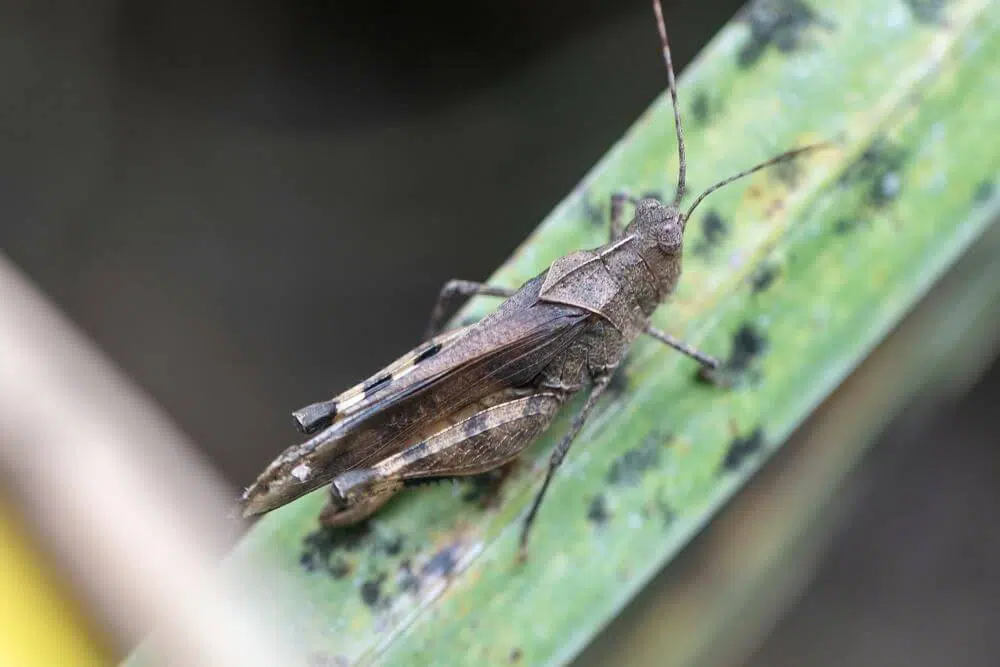
These grasshoppers (Spharagemon crepitans) are less common in parts of Florida. However, they have been seen around the state. Their biggest asset is their ability to change colors which acts as camouflage against common predators.
Part of the Oedipodinae family, these grasshoppers can change their dark brown color to a more vivid color which is believed to deter potential predators. Some data suggests they try to mimic vivid butterfly coloring to avoid predators.
28. Admirable Grasshopper

These species (Syrbula admirabilis) have been studied in detail as it’s also found in other states. The pale-color grasshopper is among the most agile in Florida. Males are believed to be a bit more agile than females.
The species can fly. It’s believed it uses this ability when facing potential danger. It can fly in short bursts of up to tens of feet at a time. This also allows it to migrate quickly and explore outer-state territories.
The Admirable Grasshopper is typically interested in remote habitats even in areas where there’s little vegetation. Studies show this grasshopper will settle in areas with grass.
It only eats grass. Research determined the Admirable Grasshopper eats up to 12 types of grass and as a result, it’s not labeled as a pest in agriculture.
29. Leather-colored Bird Grasshopper
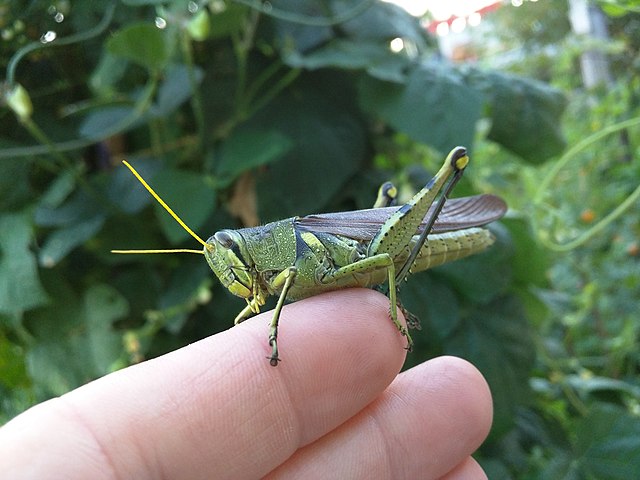
This grasshopper (Schistocerca alutacea) is very common in Florida and Southern states. Part of the Acrididae family, it can be recognized by its long green body and long brown wings.
Its wings are longer than its body which gives it good flying abilities. The invertebrate is attracted to light, reflective objects, and shiny objects. Most of its diet is comprised of various types of grass.
30. Wingless Florida Grasshopper

This grasshopper species (Floritettix aptera) is only found in Florida. It’s one of the 13 types of Floritettix grasshoppers in the Acrididae family, the largest family of grasshoppers.
This species prefers to live in dry areas. It mostly inhabits woodlands and areas with thick vegetation. It likes to live in the proximity of oaks.
This grasshopper has an all-green body. Its legs, eyes, and antennae are brown. It can be considered a small species compared to other grasshoppers in Florida. This small grasshopper grows to a maximum size of 33mm in the case of females. Males grow to an adult size between 15 and 21mm.
Further Reading: